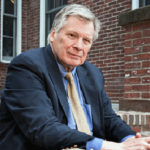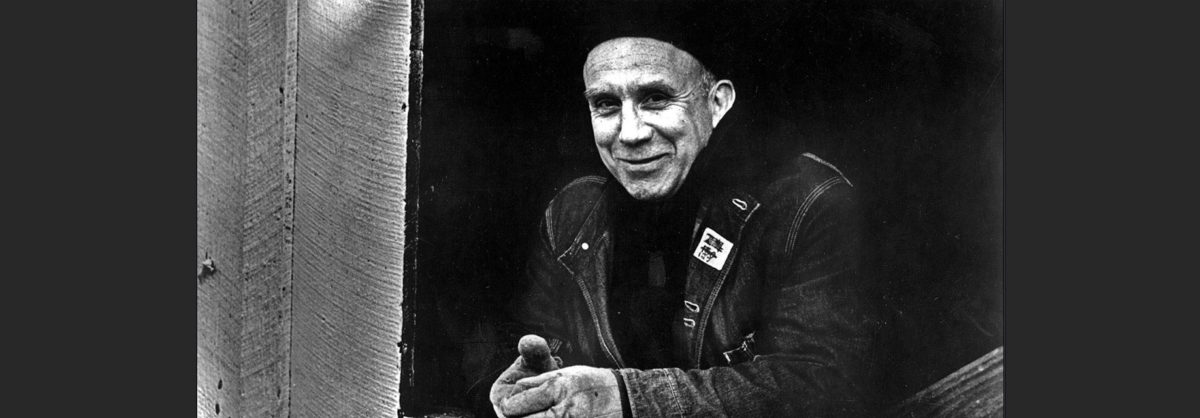My wife and I are sitting in the audience of the main hall at Thomas Aquinas College here in Northfield. There are two performers up on the stage: Louisa Stonehill, dressed in a lovely black gown, standing there stage center playing the violin, and Nicholas Burns, seated at the piano. There are perhaps 150 students and faculty in the audience, many with face masks because of this lingering Covid pestilence. First, it’s the minimalist Arvo Pärt, a few notes played over and over, with subtle repetitions. Then it’s Mendelssohn’s Violin Sonata in F. And now, after an intermission, Richard Strauss’s thirty-minute Violin Sonata in E-flat begins unweaving before us.
And there they are: the piano initiating the action, then the violinist in response. At first she responds hesitantly, then begins giving more of herself. Then more. Yes, the music is mesmerizing, but there’s something deeper going on, and I’m trying to find words—like Dante—to understand what it is I’m actually hearing. And here’s the thing: it’s the logic of words I’m trying to work with, even as the sublime music envelops and covers me in its penumbra.
And once again it’s Elizabeth Ann Seton I’m thinking of: the probing questions, the Mystery unfolding as Love itself unfolds. And you hear it: the male and female of it, the piano questioning, trying to draw closer to the chords of the violin. And there it is: three full strikes across the nerve-tingling strings of the violin! A yes, and then another yes! And then another! That slow, methodical piano introduction, like Christ leading us, step by gentle step, until we give ourselves over—if we are fortunate enough—into that exuberant Allegro. That irresistible give and take and give, ending in that shout of joy and ecstatic release.
And when I return home that night, my mind still preoccupied with what I’ve experienced, I try to understand what it was I felt in that darkened cocoon of a chamber. And sure enough, there it is: Strauss, the young composer, twenty-three years old, falling in love with Pauline de Ahna, soprano, whom he will wed and raise a family with, reaching out with the music of angels.
Which leads to my second movement: Thomas Merton. It’s September 1938, a cold, gray rainy fall day in Manhattan. Merton, also twenty-three, is studying in a small room on West 114th Street for his doctorate in English literature at Columbia University. War is on the horizon in Europe and the Far East and Merton knows it is just a matter of time before his draft notice arrives and he will, as he sardonically notes, receive “a piece of metal with my number on it … so as to help out the circulation of red-tape that would necessarily follow the disposal of my remains.”
He understands too well that in the larger scheme of things he does not matter, that his “likes or dislikes, beliefs or disbeliefs” mean absolutely nothing “in the external, political order.” Whatever his particular and unique, never-to-be-repeated consciousness might register, it means nothing to the overall welfare of the State. He is just one more individual in a world in which the individual has ceased to count.
And then he picks up a biography written by a Fr. Lahey, a Jesuit priest and scholar, some years earlier. It’s about another Jesuit priest who died half a century before whose name was Gerard Manley Hopkins. Merton has already been attracted to Hopkins by some of his poems, but now he learns that Hopkins, raised as an Anglican, and a brilliant student at Balliol College, Oxford, converted to Catholicism at the age Merton is now. And because he’s been thinking of writing his dissertation on Hopkins, he dips into Lahey’s biography and discovers that Hopkins, under the influence of John Henry Newman, himself a convert, took the bold step—against the advice of his Oxford dons and his own family’s wishes—of becoming a Roman Catholic.
And then, as Merton himself tells the story, “All of a sudden something began to stir within me, something began to push me, to prompt me: a movement that spoke like a voice. ‘What are you waiting for?’ it said. ‘Why are you sitting here? Why do you still hesitate? You know what you ought to do? Why don’t you do it?’”
He lights a cigarette, then looks out the window at the rain, trying to shut the voice up. Don’t act on your impulses, he warns himself. “This is crazy. This is not rational. Read your book.” But the voice grows even more insistent. “It’s useless to hesitate any longer,” he hears. “Why don’t you get up and go?” And then the violin chord, and he’s putting on his raincoat, and then he’s heading up Broadway in the light rain. And then, he tells us, “everything inside me began to sing.”
Then it’s over to the presbytery at Corpus Christi Church to talk to Fr. Ford, the pastor, who happens to be out. But as he leaves, he sees the priest walking down the street toward him, and he asks if he can talk to him, and the priest invites him into the parlor. And, like that, Merton blurts out that he wants to become a Catholic … now, now, or as soon as possible. And with that Fr. Ford gives him three books to read and arranges for Merton to return for instruction. And the rest is history: a rich, vibrant history which –like good music—resounds down the halls of memory.
Which leads to the third movement with its Coda. It’s Manhattan again, but it’s 135 years earlier, and we’re down around the Battery, where Elizabeth Ann Seton lives with her family and relatives. She’s thirty now, a wife, mother of five—three girls and two boys—and now a widow, her beloved husband Will gone, having succumbed to and buried in the Protestant Cemetery in Florence, Italy, following a months’ long internment in a former prison off Livorno, chillingly called the Lazaretto. She’s a devout Episcopalian associated with Trinity Church, but she has seen something in the churches and basilicas of Florence, and the faith of these Catholics, which has drawn her and continues to do so, in spite of the personal costs of leaving the Episcopal Church behind and joining those mostly despised Catholics.
And the struggle. You’re a mother now, and a widow, her dear Protestant friends remind her. And this is New York and the New World. Come, dear girl, come over to the Church of Scotland, one friend tells her. Listen to the sermons of our Presbyterian preacher, and you will find comfort. And then her dear Quaker friend, telling her, in the sweetest way possible, to come follow her. Then too there are her Anabaptist and Methodist friends, as well as her confidant and spiritual counsellor, Rev. Hobart, of Trinity Episcopal.
And then that violin strike. That yes, and that yes again! “I WILL GO PEACEABLY and FIRMLY TO THE CATHOLIC CHURCH,” she has resolved, “for if Faith is so important to our salvation, I will seek it where true Faith first began and seek it among those who received it from GOD HIMSELF.”
And so it begins, and continues down the years for the woman Elizabeth Ann Seton, who will found the Sisters of Charity and in time become the first American-born citizen to be recognized as a saint.
Yes. That violin strike. That yes, and yes again, in spite of all the crosses along with the joys she will carry in her heart in the precious time she has left.
 PAUL MARIANI is University Professor of English emeritus at Boston College. He is the author of nineteen books, including biographies of, among others, William Carlos Williams, Gerard Manley Hopkins, and Wallace Stevens. His previous volumes of poetry include Epitaphs for the Journey, The Great Wheel, and Salvage Operations. He is also the author of Thirty Days: On Retreat with the Exercises of St. Ignatius and The Mystery of It All: The Vocation of Poetry in the Twilight of Modernity.
PAUL MARIANI is University Professor of English emeritus at Boston College. He is the author of nineteen books, including biographies of, among others, William Carlos Williams, Gerard Manley Hopkins, and Wallace Stevens. His previous volumes of poetry include Epitaphs for the Journey, The Great Wheel, and Salvage Operations. He is also the author of Thirty Days: On Retreat with the Exercises of St. Ignatius and The Mystery of It All: The Vocation of Poetry in the Twilight of Modernity.
Image: Thomas Merton / Everett Collection Inc / Alamy Stock Photo
